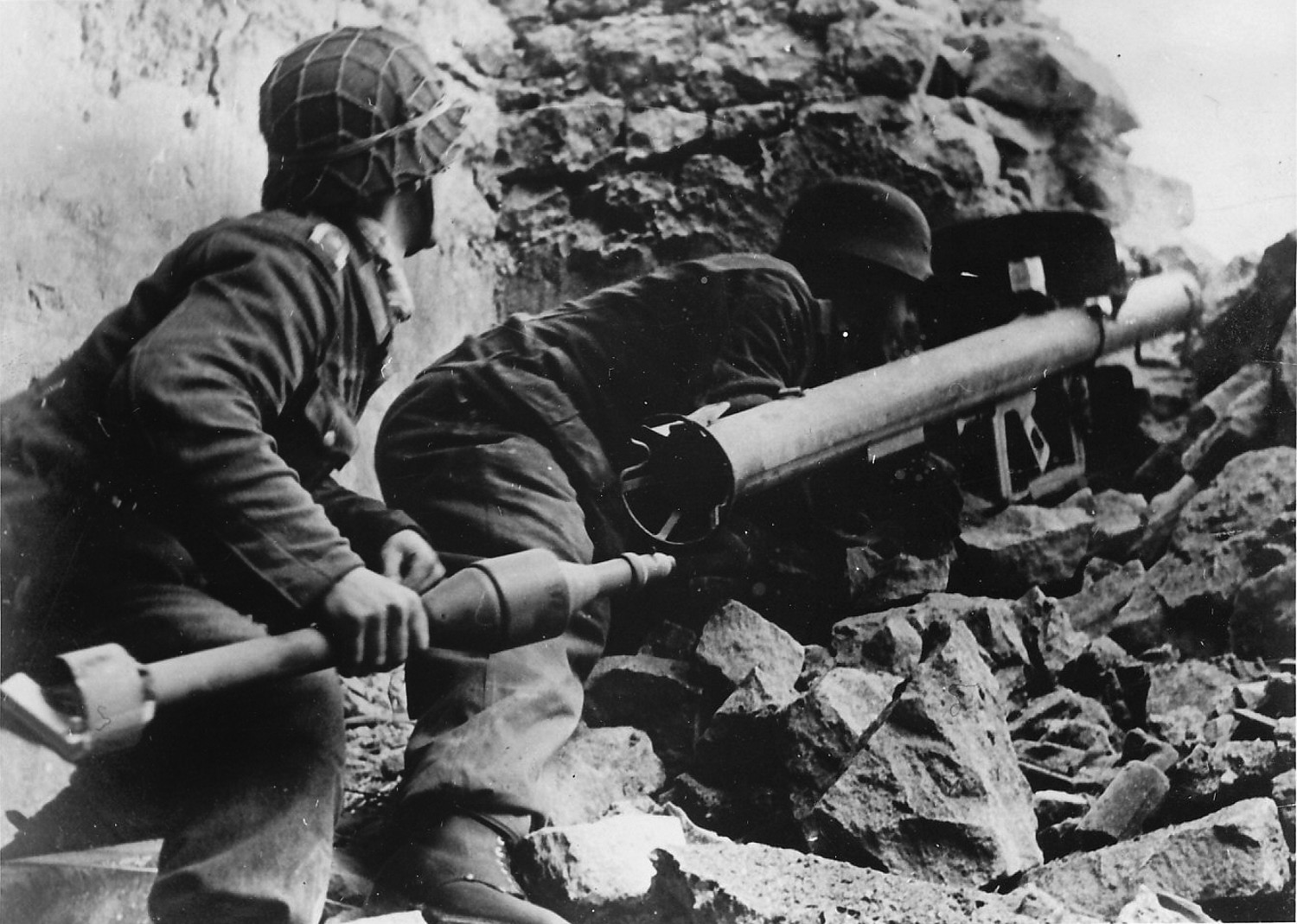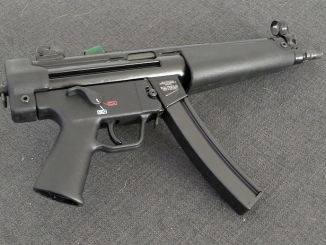This is Lot 2051 in the upcoming October 2019 Morphys Extraordinary auction.
The MP40/I was an experimental modification of the MP-40 submachine gun developed by the Erma company (we think) in late 1942. It was presumably developed in response to complaints of Soviet fire superiority with SMGs because of their large drum magazines (and also the larger number of SMGs used by the Soviet forces compared to German units).
The concept is a pretty simple one – the regular magazine housing was replaced by a much wider housing with a sliding block that held two separate standard magazines. One of the two magazines would always be positioned where it could feed and fire, and when that magazine was empty the shooter could simply slide the block to one side and move the second (still full) magazine into position to fire. The prevented the need to fish around in a slow magazine pouch to find a new magazine when a reload was needed.
However, there were several disadvantages to the dual magazine system. For one thing, an MP-40 with two full magazines hanging off it becomes quite the heavy and poorly-balanced weapon to handle and carry. The additional open areas required for the sliding block were much more prone to gather dirt and foul than the standard gun, and the extra weight on the relatively thin receiver tube often contributed to creases or other damage to the magazine well and ejection port areas of the gun, rendering them unusable. The large amount of m metal removed from the receiver tube also left it much more vulnerable to bending than a standard MP40.
Only a small number of these guns were ever made (around the middle of 1943), and very, very few survive today. They were made form preexisting gun retrofitted, and do not appear have comprised any specific serial number block. In addition to the magazine housing, the conversion process also involved slightly shortening the ejector and reshaping the bottom of the buttplate so that it would clear the new magazine release catches.




Or you can just go the James Coburn route and carry a PPSH 41.
A concept well intended and feasibly crafted in technical evaluation but poorly executed in field conditions is still a bad idea. Forget the step above magazines taped/welded together and get a new weapon design, preferably one with a more compact receiver layout. Even the M1921 now seems a better idea for “more ammunition capacity,” as it was designed for use with both drum magazines and box magazines without making the thing muzzle-heavy. I could be wrong.
It would probably have been simpler to just build a stamped steel adapter that could be attached to the PPSh’s 71-round drum to let it be used in a standard MP40.
Somebody actually did come up with an adapter to allow a PPSh-41 magazine to be used in an MP-5. It was nothing more complex than the top 8cm of the standard MP-5 magazine cut off and welded to the PPsh-41 drum over its (ground-off) feed lips, plus eight cylindrical acrylic “dummy” rounds sitting freely in the very back of the magazine’s spiral. And a free turning sheet metal “spacer” disc inside the magazine lid, about the size of an old 45 RPM vinyl phonograph record.
As the follower wound round and round, it fed 9 x 19mm cartridges just as well as it would feed 7.62 x 25mm rounds, with the spacer disc keeping them from slopping back and forth. The eight dummy rounds served to shove the last eight live rounds up the straight section to the bolt. That was all there was to it.
I’m surprised that some smart mechanic in the Wehrmacht on the Ostfront didn’t come up with something like that. They were supposed to be geniuses, you know.
cheers
eon
“(…)I’m surprised that some smart mechanic in the Wehrmacht on the Ostfront didn’t come up with something like that.(…)”
But that would require usage of (I presume) working magazine, which might be used without modification together with MP 717(r)
“(…)adapter(…)”
Would it be possible to adopt SUOMI drum magazine for MP40?
The SUOMI drum is better supported where it locks into the receiver, so it probably would work, but you have the problem of drum magazines. They don’t carry well. Updated SUOMI mags were the coffin mags.
This dual magazine idea is ingenious, but at what cost?
“(…)tep above magazines taped/welded together(…)”
Much later, Chileans developed interesting solution, which between this and MP40/I. It was used in FAMAE S.A.F.:
https://modernfirearms.net/en/submachine-guns/chile-submachine-guns/famae-s-a-f-eng/
Magazines had special studs and slots that allowed two or more magazines to be clipped together for quicker magazine change.
Thus it do not require weapon rebuild and magazines can be used in single-mode too, unlike welded.
Shhhhh, Don’t let the Wehraboos hear you! Everyone knows that Hitler period weapons were beyond compare and absolutely perfect in every regard!! Even now we are copying what the Ubermensch came up with under his benevolent rule…
Yeah, sure, like the V3 super artillery that didn’t get a kill count that amounted to anything over 10 civilians? I laugh at the idea.
Yes, and the civilians it killed were the technicians working on it when part of the barrel blew out.
Herr Conders’ Hochdruckpumpe gun was yet another project that greatly cheered my uncles who served in the ETO. Like all the other Wunderwaffe that didn’t work, the RM Hitler wasted on it was that much less he and the Wehrmacht and Luftwaffe had to spend on tanks and guns and aircraft to throw at my uncles as they rolled across occupied France, Belgium, and etc. enroute to Berlin.
cheers
eon
“(…)Hochdruckpumpe(…)”
Well, other nations through history also experienced investing resources in development of military inventions hoping possibilities earlier unheard of, which eventually ended far below expectations. See for example Secter howitzer https://en.wikipedia.org/wiki/Secret_howitzer (Russian Empire) xor Christmas Bullet http://www.fiddlersgreen.net/models/aircraft/Christmas-Bullet.html
which was (according to its designer) the fastest, safest and most efficient airplanes on Earth, whilst in fact two prototypes crashed on their maiden flights, shortly after take-off…
Nonetheless he was able to persuade US Army to paid him $100,000 bill for his ‘revolutionary’ wing design
–
As later aviation experience showed, so-called flatter of wings should be avoided, not encouraged.
Your uncle was of course right. But for the record, the name is Coenders (not Cönders). A most irritating feature of wartime and postwar intelligence reports to me is the prevailing total disinterest in getting the names right. After all, there were lots of criminals to go after. Wouldn’t it have helped if at least the names had been verified?
An admiration for German equipment does not blind one to shortcomings. I am 1) a National Socialist born out of season, 2) an implacable critic of the P-38 pistol as opposed to the Browning Hi-Power, and a fan of the Garand as opposed to the Mauser 98. GTFU
Not the worst concept i have ever seen that’s for sure but that being said mag clamps or tape or wire could have accomplished the same thing really. The problem with that though is not being able to use the standard mag pouches once they’re clamped.Also the combat loadout I believe was six mags in two 3mag pouches ( and many carried more)so I’m not quite sure why Ian kept saying you would need to reload magazines unless maybe they were your last two.
Actually take the UD-42’s idea of purpose built back to back magazines. Ian’s even done a video on that weapon https://www.youtube.com/watch?v=fnGoAWhVUxc
That big open area at the bottom side of the magwell to allow the entry of dirt too, it’s just asking for malfunctions.
It’s a very German solution to a problem more easily solved by taping two magazines together like GIs did with M1 carbines during the war and almost everyone with SMGs and rifles postwar. Even a multi stack “coffin” magazine like the Surefire would have been simpler operationally and logistically even if the engineering was harder.
This reminds me of the Mercedes 4-Matic cars from the 80s which were an order of magnitude more complex than the Audi Quattro for the same result.
“(…) Audi Quattro(…)”
Uhm… that this is also German product.
I think that in 1940s Germany, cause for such “jitter” in military designs was requirements inflexibility, my observation is that Germans after having requirements stated were eager to full-fill it, but very unwilling to alter it even if experience showed that they are serious obstacle and at same time provide very small if any advantage. Take for example G41(M) (NO gas port in barrel!) or even PzKpfw. V (in 1930s German decided that gearbox will be in front, in result their tank very bigger and heavier than they need to be, c.f. M26 Pershing) or He 177 4-engine 2-propellor bomber.
I suspect that someone ordered method of increasing MP40 capacity, with compulsory usage of default (not altered) magazines.
The “taping together” proposal in my opinion is based on technology of modern tape. When I was a child, the tapes available were orders of magnitude less reliable than modern tapes. If I remember correctly, there was basically only one type apart from much too thin Scotchtape (Tesafilm in German), called “Isolierband” in German. If wet, it lost most of its stability.
In the forties, I think, “taping together” was not a solution that came to mind as easily as today.
Dr. Frahkensteen? I see what you did there… and also, over there
https://giphygifs.s3.amazonaws.com/media/bHfXNE0684iti/giphy.gif
The EMP 44 double mag system works in a better and different way in that the
double mag “box” swings across in a parallelogram arrangement which requires
less of the receiver tube to be cut away